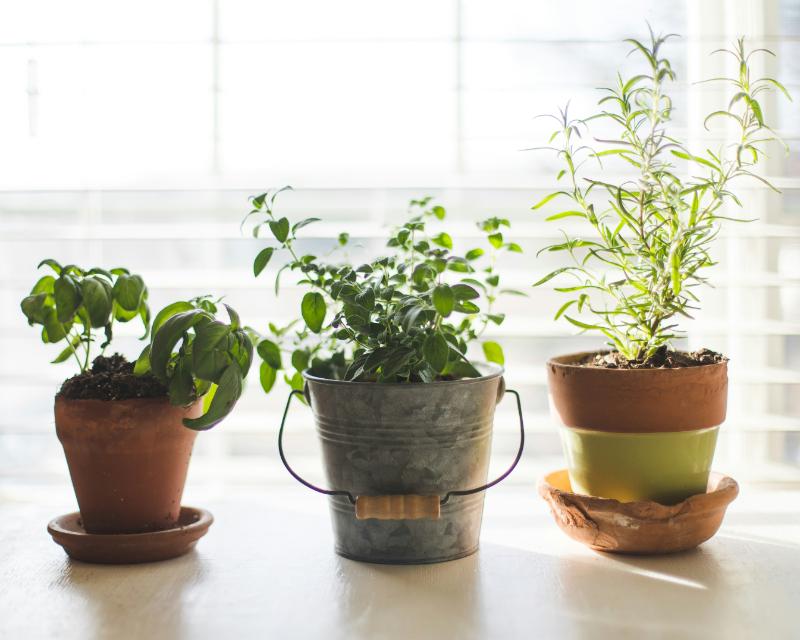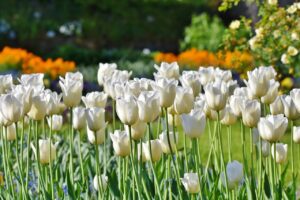Herbs are an easy plant to grow indoors and offer both a beautiful fragrance and a tasty addition to even the simplest of dishes. A bright windowsill is often the best environment for these plants and with a little bit of care, you can use and enjoy them again and again.
What do I need for my indoor herbs?
Growing indoor herbs is pretty easy and you only need a few items to get started. Here is a small list of things to get you on your way:
- Selection of pots
- Good quality, peat-free soil
- Horticultural grit
- Seeds or plants – some herbs, including rosemary, thyme and oregano are slow growing so are best purchased as a small plant whereas cress, parsley and mint can all be started from seed successfully
- Water

How to grow herbs indoors
The first thing to look at is the space you have available and the types of herbs you wish to grow. Try not to grow what you won’t use so look at your favourite recipes and decide which flavours you’d love to add regularly.
Pots can be found in all shapes and sizes, so you can choose those that match your décor. The only requirement is sufficient drainage, and it is a good idea to have a pot with a saucer underneath so that excess water doesn’t damage your windowsill or furniture.
Can I grow herbs in one pot?
You can plant herbs together in one pot, but different types have different watering needs whereas others can be thugs – mint in particular can take over, so consider placing this in a separate container.
The following plants thrive together:
- Dry and gritty soil – Rosemary and Thyme
- Moist soil – Mint, chives, and basil
- Bright sunny spot – Thyme, sage, oregano, and rosemary
- Partial shade – Parsley, chives, coriander
Once you have your location and your container (s), fill them with good quality, peat-free topsoil. It can be worth mixing through some potting grit with your soil as certain herbs, such as the Mediterranean varieties, flourish in drier, gritty conditions. Carefully plant your small plant or sow your seed according to the package instructions, water and wait!
Best herbs to grow indoors
There are lots of herbs to choose from. We’ve picked out the best herbs to grow indoors and their uses so you can make the most out of them!
Mint
There are a wide number of varieties of mint from simple garden mint through to pineapple, chocolate, or apple mint. Try a few different ones to vary the flavour and see which you prefer.
Mint likes a bright, sunny spot with warm temperatures and moist soil. A mint container should ideally be wide and fairly shallow. To keep your plant ‘bushy’, trim every couple of weeks by snipping off the stems just above a set of leaves.
Mint can be used for hot or cold tea, is delicious with new potatoes, feta, or peas and is essential in a Pimms or Mojito! To use, simply remove individual leaves and cut them up or pop them in whole.

Basil
Basil plants love both heat and light so will grow best on a very sunny windowsill, ideally south-facing. If you don’t have anywhere sunny enough you can purchase a grow light and there are lots of options available for a variety of price ranges. Basil can either be grown from a purchased plant or from seed, but plants will need replacing or seeds resowing to keep a continuous crop.
Basil adores tomatoes and the two go together to make a simple, delicious salad. You can also make your own fresh and delicious pesto by whizzing together the leaves with olive oil, garlic, pine nuts or almonds and parmesan cheese.
Parsley
There are two main types of parsley, curled and flat leaf, and both are easy to grow indoors in a bright spot. Growing from seed will allow you to harvest from your plant in approximately 8 – 12 weeks so if you are in a hurry, grow this herb from small plants purchased at your local garden centre.
Curly leaf parsley is generally used as a garnish and will brighten any dish whereas flat leaf parsley has a stronger flavour so tends to be used for cooking. Both varieties can be picked, chopped and frozen, either loose in a sandwich bag or in an ice cube tray with water so that you can pop this into any soup or sauce.

Coriander
Are you a lover or a hater? Coriander is a polarizing herb but if you love it, you will want a constant, fresh supply – and the good news is it’s easy to grow! The best way to grow is by seed so that you can sow every couple of weeks to keep that continuous supply but don’t harvest more than 25% of each plant at a time or it will not survive.
You can use both the leaves and the stalks of coriander and stir through or sprinkle on Asian, Oriental, or Middle Eastern dishes.
Chives
One of the most problem-free herbs to grow as they are very unfussy, growing in bright light or partial shade. Buy as a small plant and chop regularly to keep a good supply as harvesting the leaves will stimulate growth.
Chives have a fresh, oniony taste and work wonderfully in soups and salads.
Thyme
A fantastic Mediterranean herb with an earthy flavour. Thyme comes in many different varieties, and all are edible, working well in stews and soups or as part of a rub for meat. Try also growing Lemon Thyme which works very well with seafood.
Oregano
Oregano is a beautiful-smelling herb that will thrive in your sunniest spot and in the driest, grittiest soil. Add to any Italian dishes such as tomato-based pasta sauces or sprinkle on homemade pizza.

Rosemary
Rosemary will live happily in any free-draining soil so will really benefit from mixing in some potting grit to your growing medium. The leaves can be removed, chopped, and added to any Mediterranean dish, but Rosemary pairs particularly well with beef. Try using the sprigs as skewers if you are barbecuing, or toss straight onto the coals to flavour the smoke.
Growing your herbs indoors means you can have a year-round supply of something that looks, smells and tastes fantastic while also saving yourself some money off the supermarket shop.
Outdoor herb garden
If you have the space, you can also grow herbs outside. If you want to create your own outdoor herb garden, we’ve created an easy-to-follow guide on how to make a herb garden.




